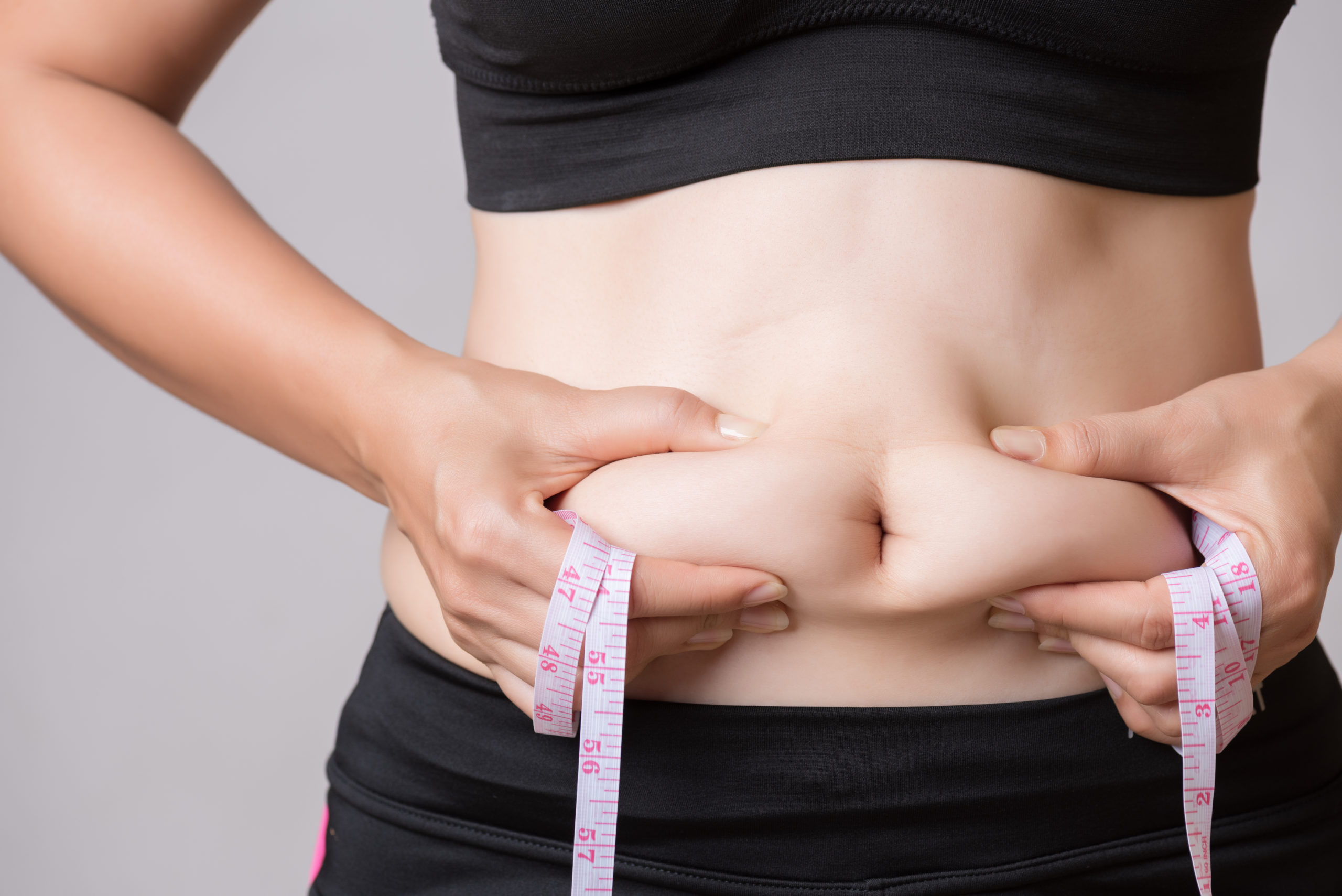
Maintaining a low percentage of visceral fat is essential for your health. This form of ‘hidden’ fat that sits around the internal organs poses a serious health risk due to the type of molecules it releases into the rest of the body.
Visceral vs Subcutaneous Fat
Fat was once thought of as a passive storage: excess energy sitting in various places on the body, waiting to be used up. However, since the 1990s researchers have discovered that fat cells, and in particular visceral fat cells, are biologically active1. Both subcutaneous and visceral fat release different forms of chemicals into the body. While subcutaneous fat produces some beneficial molecules (including those that help regulate appetite and the processing of fats and sugars), visceral fat produces more harmful chemicals. One of these is a protein called cytokine, which can trigger low level inflammation (a pre-cursor and risk factor for a number of health conditions such as heart disease) and a molecule called RBP4, which increases insulin resistance2.
The link between excess visceral fat and chronic disease is considered strong345across the medical science community, which is why it is mentioned so often by health and fitness professionals. Although reducing or keeping your visceral fat levels to within a safe range is not a guarantee of perfect lifelong health, it does reduce the risk of diseases that could significantly impair your quality of life or shorten your lifespan.
Reducing Visceral Fat
You have probably heard that ‘spot’ targeting fat is not possible – doing more sit ups will not reduce visceral or subcutaneous fat, for example, although it will strengthen and tighten abdominal muscles. However, visceral fat responds faster to diet and exercise changes than subcutaneous fat does6., which means losing the fat hidden behind your abdominal wall can be done by following simple general health advice.
Move for 30 minutes a day
Exercise has been shown to be crucial to reducing visceral fat, as well as preventing its build up in the first place7. Aerobic activity, such as brisk walking or casual cycling, or strength exercises (lifting weights of body weight) are both good ways to reduce visceral fat. Taking the stairs or parking an extra block away from the train station so you walk an additional 500 metres also counts. Mix and match aerobic and strength exercises over the week to maintain muscle and physical endurance8.
The key is to make moderate exercise a regular part of your life – just 30 minutes a day is considered sufficient.
Eat healthy
Eat a balanced diet with plenty of vegetables and wholegrains and minimise your intake of sweetened foods and foods high in trans fats9. A plant-based diet, low in highly processed foods10, and supported with small amounts of meat or dairy (as your preferences permit) is linked to better gut health11 and lower levels of visceral fat1213.
If you have dietary restrictions or are considering a vegetarian or vegan diet, consult with your GP and/or a dietician to ensure you get all the nutrients you need from your meals.
Get some sleep… but not too much
Everyone has slightly different sleep needs, and these change as we age. However, science has proven that getting the right amount of sleep for you is crucial for good health. The right amount of sleep is linked to decision making and learning abilities, as well as mood stability and physical health14. Studies have established a clear link between lack of and excess sleep with high levels of visceral fat1516. It’s generally recommended that adults under 65 get more than 7-9 hours of sleep every night17. Adults older than 65 might need slightly less. Teenagers should aim for about 8 -10 hours a night.
Monitor mental health
The link between mental health and excess fat is undeniable, with many studies showing a clear relationship between depressive symptoms and excess fat181920. A build up of the stress hormone cortisol is associated with an increase in visceral fat2122. The signs of an unhealthy amount of stress can include mood swings, insomnia, sadness, upset stomach, or changes in sex drive23. These differ from person to person and you know yourself best – if you have been feeling ‘off’ for a while (more than two weeks), visit a supportive GP to check on your mental health.
Don’t smoke
Smoking has been linked to high levels of visceral fat, especially amongst smokers who already struggle with their weight. The relationship between smoking and body fat is not completely understood. However, studies have found that heavy smoking is linked to obesity and risky health behaviours such as high alcohol intake, less physical activity and poor diet. Studies have also found that smokers tend to have a larger waist circumference and a smaller hip circumference than on smokers, which is indicative of higher levels of visceral fat and lower muscle mass at the hips24.
Measuring Your Achievements
Measuring your body regularly is the best way to keep track of your physical health and get an idea of your fat levels. A measuring tape is all you need. A waist circumference of 94 centimetres or more is considered a risk for men. For women, the measurement is 80 centimetres25. These are generalised measurements, so it is important to understand what is healthy for you – consult with your GP and undertake more specific testing.
A body composition scan will allow you to ‘see’ the balance of visceral and subcutaneous fat in your body, as well as other crucial measurements like skeletal muscle mass and bone density. Check on these regularly over the long term to keep an eye on your physical health and the progress you make with improved diet and exercise.
________________________________________________________________
[1] https://www.health.harvard.edu/staying-healthy/taking-aim-at-belly-fat
[2] https://www.health.harvard.edu/staying-healthy/taking-aim-at-belly-fat
[3] https://www.ncbi.nlm.nih.gov/pmc/articles/PMC5619737/
[4] https://www.health.harvard.edu/staying-healthy/abdominal-obesity-and-your-health
[5] https://www.ncbi.nlm.nih.gov/pmc/articles/PMC3473928/
[6] https://www.healthdirect.gov.au/how-to-reduce-visceral-body-fat-hidden-fat
[8] https://extension.psu.edu/strength-training-versus-aerobic-training-which-is-better-for-my-health
[10] https://www.health.harvard.edu/staying-healthy/not-all-processed-foods-are-unhealthy
[11] https://nutritionj.biomedcentral.com/articles/10.1186/s12937-018-0381-7
[12] https://www.ncbi.nlm.nih.gov/pmc/articles/PMC6221888/
[13] https://pubmed.ncbi.nlm.nih.gov/30223451/
[15] https://pubmed.ncbi.nlm.nih.gov/24420871/
[16] https://www.ncbi.nlm.nih.gov/pmc/articles/PMC2831422/
[17] https://www.sleephealthfoundation.org.au/how-much-sleep-do-you-really-need.html
[19] https://www.ncbi.nlm.nih.gov/pmc/articles/PMC5520803/
[20] https://www.ncbi.nlm.nih.gov/pmc/articles/PMC2739059/
[21] https://www.health.harvard.edu/staying-healthy/taking-aim-at-belly-fat
[22] https://www.sciencedaily.com/releases/2000/11/001120072314.htm
[23] https://www.healthdirect.gov.au/stress-symptoms
[24] https://academic.oup.com/ajcn/article/87/4/801/4633357
[25] https://www.heartfoundation.org.au/Heart-health-education/Healthy-Body-Weight